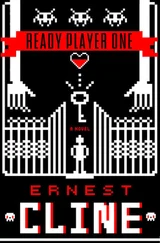Cline Ernest - Ready Player One
Здесь есть возможность читать онлайн «Cline Ernest - Ready Player One» весь текст электронной книги совершенно бесплатно (целиком полную версию без сокращений). В некоторых случаях можно слушать аудио, скачать через торрент в формате fb2 и присутствует краткое содержание. Год выпуска: 2011, ISBN: 2011, Издательство: Crown, Жанр: Старинная литература, на английском языке. Описание произведения, (предисловие) а так же отзывы посетителей доступны на портале библиотеки ЛибКат.
- Название:Ready Player One
- Автор:
- Издательство:Crown
- Жанр:
- Год:2011
- ISBN:9780307887450
- Рейтинг книги:4.67 / 5. Голосов: 3
-
Избранное:Добавить в избранное
- Отзывы:
-
Ваша оценка:
- 100
- 1
- 2
- 3
- 4
- 5
Ready Player One: краткое содержание, описание и аннотация
Предлагаем к чтению аннотацию, описание, краткое содержание или предисловие (зависит от того, что написал сам автор книги «Ready Player One»). Если вы не нашли необходимую информацию о книге — напишите в комментариях, мы постараемся отыскать её.
Ready Player One — читать онлайн бесплатно полную книгу (весь текст) целиком
Ниже представлен текст книги, разбитый по страницам. Система сохранения места последней прочитанной страницы, позволяет с удобством читать онлайн бесплатно книгу «Ready Player One», без необходимости каждый раз заново искать на чём Вы остановились. Поставьте закладку, и сможете в любой момент перейти на страницу, на которой закончили чтение.
Интервал:
Закладка:
In the days before the OASIS, massively multiplayer online games (MMOs) were among the first shared synthetic environments. They allowed thousands of players to simultaneously coexist inside a simulated world, which they connected to via the Internet. The overall size of these environments was relatively small, usually just a single world, or a dozen or so small planets. MMO players could only see these online environments through a small two-dimensional window—their desktop computer monitor—and they could only interact with it by using keyboards, mice, and other crude input devices.
Gregarious Simulation Systems elevated the MMO concept to an entirely new level. The OASIS didn’t limit its users to just one planet, or even a dozen. The OASIS contained hundreds (and eventually thousands) of high-resolution 3-D worlds for people to explore, and each one was beautifully rendered in meticulous graphical detail, right down to bugs and blades of grass, wind and weather patterns. Users could circumnavigate each of these planets and never see the same terrain twice. Even in its first primitive incarnation, the scope of the simulation was staggering.
Halliday and Morrow referred to the OASIS as an “open-source reality,” a malleable online universe that anyone could access via the Internet, using their existing home computer or videogame console. You could log in and instantly escape the drudgery of your day-to-day life. You could create an entirely new persona for yourself, with complete control over how you looked and sounded to others. In the OASIS, the fat could become thin, the ugly could become beautiful, and the shy, extroverted. Or vice versa. You could change your name, age, sex, race, height, weight, voice, hair color, and bone structure. Or you could cease being human altogether, and become an elf, ogre, alien, or any other creature from literature, movies, or mythology.
In the OASIS, you could become whomever and whatever you wanted to be, without ever revealing your true identity, because your anonymity was guaranteed.
Users could also alter the content of the virtual worlds inside the OASIS, or create entirely new ones. A person’s online presence was no longer limited to a website or a social-networking profile. In the OASIS, you could create your own private planet, build a virtual mansion on it, furnish and decorate it however you liked, and invite a few thousand friends over for a party. And those friends could be in a dozen different time zones, spread all over the globe.
The keys to the success of the OASIS were the two new pieces of interface hardware that GSS had created, both of which were required to access the simulation: the OASIS visor and haptic gloves.
The wireless one-size-fits-all OASIS visor was slightly larger than a pair of sunglasses. It used harmless low-powered lasers to draw the stunningly real environment of the OASIS right onto its wearer’s retinas, completely immersing their entire field of vision in the online world. The visor was light-years ahead of the clunky virtual-reality goggles available prior to that time, and it represented a paradigm shift in virtual-reality technology—as did the lightweight OASIS haptic gloves, which allowed users to directly control the hands of their avatar and to interact with their simulated environment as if they were actually inside it. When you picked up objects, opened doors, or operated vehicles, the haptic gloves made you feel these nonexistent objects and surfaces as if they were really right there in front of you. The gloves let you, as the television ads put it, “reach in and touch the OASIS.” Working together, the visor and the gloves made entering the OASIS an experience unlike anything else available, and once people got a taste of it, there was no going back.
The software that powered the simulation, Halliday’s new OASIS Reality Engine, also represented a huge technological breakthrough. It managed to overcome limitations that had plagued previous simulated realities. In addition to restricting the overall size of their virtual environments, earlier MMOs had been forced to limit their virtual populations, usually to a few thousand users per server. If too many people were logged in at the same time, the simulation would slow to a crawl and avatars would freeze in midstride as the system struggled to keep up. But the OASIS utilized a new kind of fault-tolerant server array that could draw additional processing power from every computer connected to it. At the time of its initial launch, the OASIS could handle up to five million simultaneous users, with no discernible latency and no chance of a system crash.
A massive marketing campaign promoted the launch of the OASIS. The pervasive television, billboard, and Internet ads featured a lush green oasis, complete with palm trees and a pool of crystal blue water, surrounded on all sides by a vast barren desert.
GSS’s new endeavor was a massive success from day one. The OASIS was what people had been dreaming of for decades. The “virtual reality” they had been promised for so long was finally here, and it was even better than they’d imagined. The OASIS was an online utopia, a holodeck for the home. And its biggest selling point? It was free .
Most online games of the day generated revenue by charging users a monthly subscription fee for access. GSS only charged a onetime sign-up fee of twenty-five cents , for which you received a lifetime OASIS account. The ads all used the same tagline: The OASIS—it’s the greatest videogame ever created, and it only costs a quarter .
At a time of drastic social and cultural upheaval, when most of the world’s population longed for an escape from reality, the OASIS provided it, in a form that was cheap, legal, safe, and not (medically proven to be) addictive. The ongoing energy crisis contributed greatly to the OASIS’s runaway popularity. The skyrocketing cost of oil made airline and automobile travel too expensive for the average citizen, and the OASIS became the only getaway most people could afford. As the era of cheap, abundant energy drew to a close, poverty and unrest began to spread like a virus. Every day, more and more people had reason to seek solace inside Halliday and Morrow’s virtual utopia.
Any business that wanted to set up shop inside the OASIS had to rent or purchase virtual real estate (which Morrow dubbed “surreal estate”) from GSS. Anticipating this, the company had set aside Sector One as the simulation’s designated business zone and began to sell and rent millions of blocks of surreal estate there. City-sized shopping malls were erected in the blink of an eye, and storefronts spread across planets like time-lapse footage of mold devouring an orange. Urban development had never been so easy.
In addition to the billions of dollars that GSS raked in selling land that didn’t actually exist, they made a killing selling virtual objects and vehicles. The OASIS became such an integral part of people’s day-to-day social lives that users were more than willing to shell out real money to buy accessories for their avatars: clothing, furniture, houses, flying cars, magic swords and machine guns. These items were nothing but ones and zeros stored on the OASIS servers, but they were also status symbols. Most items only cost a few credits, but since they cost nothing for GSS to manufacture, it was all profit. Even in the throes of an ongoing economic recession, the OASIS allowed Americans to continue engaging in their favorite pastime: shopping.
The OASIS quickly became the single most popular use for the Internet, so much so that the terms “OASIS” and “Internet” gradually became synonymous. And the incredibly easy-to-use three-dimensional OASIS OS, which GSS gave away for free, became the single most popular computer operating system in the world.
Читать дальшеИнтервал:
Закладка:
Похожие книги на «Ready Player One»
Представляем Вашему вниманию похожие книги на «Ready Player One» списком для выбора. Мы отобрали схожую по названию и смыслу литературу в надежде предоставить читателям больше вариантов отыскать новые, интересные, ещё непрочитанные произведения.
Обсуждение, отзывы о книге «Ready Player One» и просто собственные мнения читателей. Оставьте ваши комментарии, напишите, что Вы думаете о произведении, его смысле или главных героях. Укажите что конкретно понравилось, а что нет, и почему Вы так считаете.




![Эрнест Клайн - Ready Player Two [calibre]](/books/438636/ernest-klajn-ready-player-two-calibre-thumb.webp)







